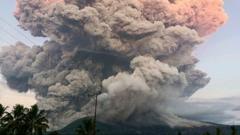Is Indonesia Facing a Major Crisis with Its Volcano Eruption?

Understanding Mount Lewotobi Laki-Laki: Indonesia's Volcanic Powerhouse
Mount Lewotobi Laki-Laki, one of Indonesia's most active volcanoes, has gained significant attention recently due to its powerful eruptions, particularly its latest event that sent a massive ash cloud soaring over 11 kilometers into the sky. This article delves into the intricacies of this remarkable geological phenomenon, examining its history, the science behind volcanic eruptions, and the impact on local communities. With Indonesia being home to numerous volcanoes due to its position on the Pacific Ring of Fire, understanding the dynamics of Lewotobi Laki-Laki is crucial for both residents and travelers.
The Geography and Characteristics of Mount Lewotobi
Mount Lewotobi is located on the beautiful island of Flores, which is part of Indonesia's vast archipelago. This twin-peaked volcano consists of two summits: Lewotobi Laki-Laki (the "Man") standing at 1,584 meters, and Lewotobi Perempuan (the "Woman") towering at 1,703 meters. The two peaks embody a unique geological relationship, with Laki-Laki exhibiting more vigorous volcanic activity.
- Location: Flores, Indonesia
- Height: Laki-Laki - 1,584 meters; Perempuan - 1,703 meters
- Type: Stratovolcano
- Last Major Eruption: November 2023
Volcanic Activity in Indonesia
Indonesia is renowned for its volcanic activity, with 127 active volcanoes scattered across its islands. The country is situated on the Pacific Ring of Fire, a tectonic plate boundary that experiences frequent seismic activity. This geological positioning makes Indonesia one of the most volcanically active regions in the world.
Volcanoes like Lewotobi Laki-Laki are characterized by their stratovolcanic nature, which means they are built up by the alternating layers of lava flows, volcanic ash, and other volcanic debris. The explosive eruptions from these volcanoes can produce large ash clouds, pyroclastic flows, and lava flows, posing significant risks to surrounding communities.
The Recent Eruption: A Detailed Overview
On Tuesday, the 14th of November 2023, Mount Lewotobi Laki-Laki erupted dramatically, prompting officials to issue the highest alert level. At approximately 17:35 local time, the volcano expelled an ash cloud that rose over 11 kilometers into the atmosphere, significantly impacting air travel and local life.
Immediate Effects of the Eruption
The eruption resulted in the establishment of a 7-kilometer exclusion zone around the volcano’s crater to ensure the safety of nearby residents. Authorities urged the local population to avoid any activities within this zone due to the potential hazards posed by the eruption and subsequent volcanic activity.
- Exclusion Zone: 7 kilometers around the crater
- Evacuations: One village evacuated; ash rain reported in others
- Health Precautions: Residents advised to wear masks to protect against ash inhalation
Geological Implications
According to Muhammad Wafid, head of Indonesia's geology agency, the eruption also raised concerns about lahar floods, which are mudflows composed of volcanic debris and water that can occur during heavy rainfall. Such events can be catastrophic, leading to loss of property and life. The ongoing seismic activity at Lewotobi indicates that further eruptions could occur, keeping local authorities on high alert.
The Impact on Local Communities
The implications of volcanic eruptions extend beyond immediate geological hazards; they also affect the social and economic fabric of local communities. With the ash cloud resulting in flight cancellations and disruptions to daily life, residents face numerous challenges.
Economic Consequences
For many communities in proximity to Mount Lewotobi, tourism is a significant source of income. The ash clouds and active eruptions disrupt travel plans, leading to cancellations and loss of revenue for local businesses. Additionally, the destruction of agricultural land due to ash fallout can have long-lasting effects on food supply and income for farmers.
Community Resilience and Preparedness
In response to the potential dangers posed by volcanic activity, local governments and organizations have developed disaster preparedness plans. These plans include:
- Evacuation Routes: Clearly marked paths for residents to follow in case of an emergency.
- Education Programs: Informing communities about volcanic hazards and safety measures.
- Health Initiatives: Providing masks and respirators to protect against ash inhalation.
Community resilience is crucial in the face of such natural disasters. By fostering a culture of preparedness and response, residents can better navigate the challenges posed by volcanic activity.
The Scientific Study of Volcanic Eruptions
Understanding the science behind volcanic eruptions is essential for predicting future events and minimizing their impact. Scientists study various aspects of volcanology, including magma movement, gas emissions, and seismic activity, to gauge the likelihood of an eruption.
Monitoring and Prediction Techniques
Authorities utilize several monitoring techniques to track volcanic activity. These include:
- Seismography: Detecting tremors that indicate magma movement beneath the surface.
- Gas Emissions: Analyzing gas release to understand the volcanic process and potential eruptions.
- Thermal Imaging: Using satellite technology to monitor temperature changes in and around the volcano.
These methods allow scientists to provide timely warnings to communities, reducing the risk of casualties and damage during eruptions.
Historical Context and Previous Eruptions
Mount Lewotobi Laki-Laki has experienced several notable eruptions throughout its history. The last significant eruption prior to the current activity occurred in May 2023, when authorities also raised the alert level. Understanding the historical context of the volcano's eruptions can provide insights into its current behavior.
Lessons from the Past
Each eruption presents unique challenges and lessons for scientists and local communities. Previous eruptions have helped refine monitoring techniques and improve disaster response strategies. For example, the eruption in November 2022 led to improved evacuation procedures that were implemented during the recent events.
Conclusion: The Ongoing Challenge of Volcanic Activity
The recent eruptions of Mount Lewotobi Laki-Laki serve as a stark reminder of the power and unpredictability of nature. While the immediate threats of ash clouds and lahars pose significant risks to local communities, the ongoing study of volcanic activity helps mitigate these dangers. As we continue to learn more about the dynamics of volcanoes, we can better prepare for future eruptions and safeguard the lives and livelihoods of those living in their shadow.
In light of Mount Lewotobi's recent activity, it is essential to remain informed and prepared. Whether you are a resident of Flores or a traveler planning to visit, understanding the risks associated with volcanic eruptions can go a long way in ensuring safety and resilience.
FAQs About Mount Lewotobi Laki-Laki
What is the latest eruption date of Mount Lewotobi Laki-Laki?
The latest eruption occurred on November 14, 2023, resulting in a significant ash cloud.
What precautions should residents take during a volcanic eruption?
Residents should avoid the exclusion zone, wear masks to protect against ash, and be prepared for potential evacuations.
How does volcanic activity affect air travel?
Volcanic ash clouds can disrupt air travel by reducing visibility and damaging aircraft engines, leading to cancellations and delays.
What are lahars, and why are they dangerous?
Lahars are mudflows made of volcanic debris and water. They can be extremely dangerous, especially during heavy rainfall, as they can sweep away anything in their path.
As we reflect on the powerful forces of nature represented by Mount Lewotobi Laki-Laki, we are reminded of the importance of preparedness and resilience in the face of such unpredictable events. How do you think communities can better prepare for natural disasters in the future? #VolcanoSafety #LewotobiLakiLaki #NaturalDisasters
Published: 2025-06-17 19:55:18 | Category: technology



